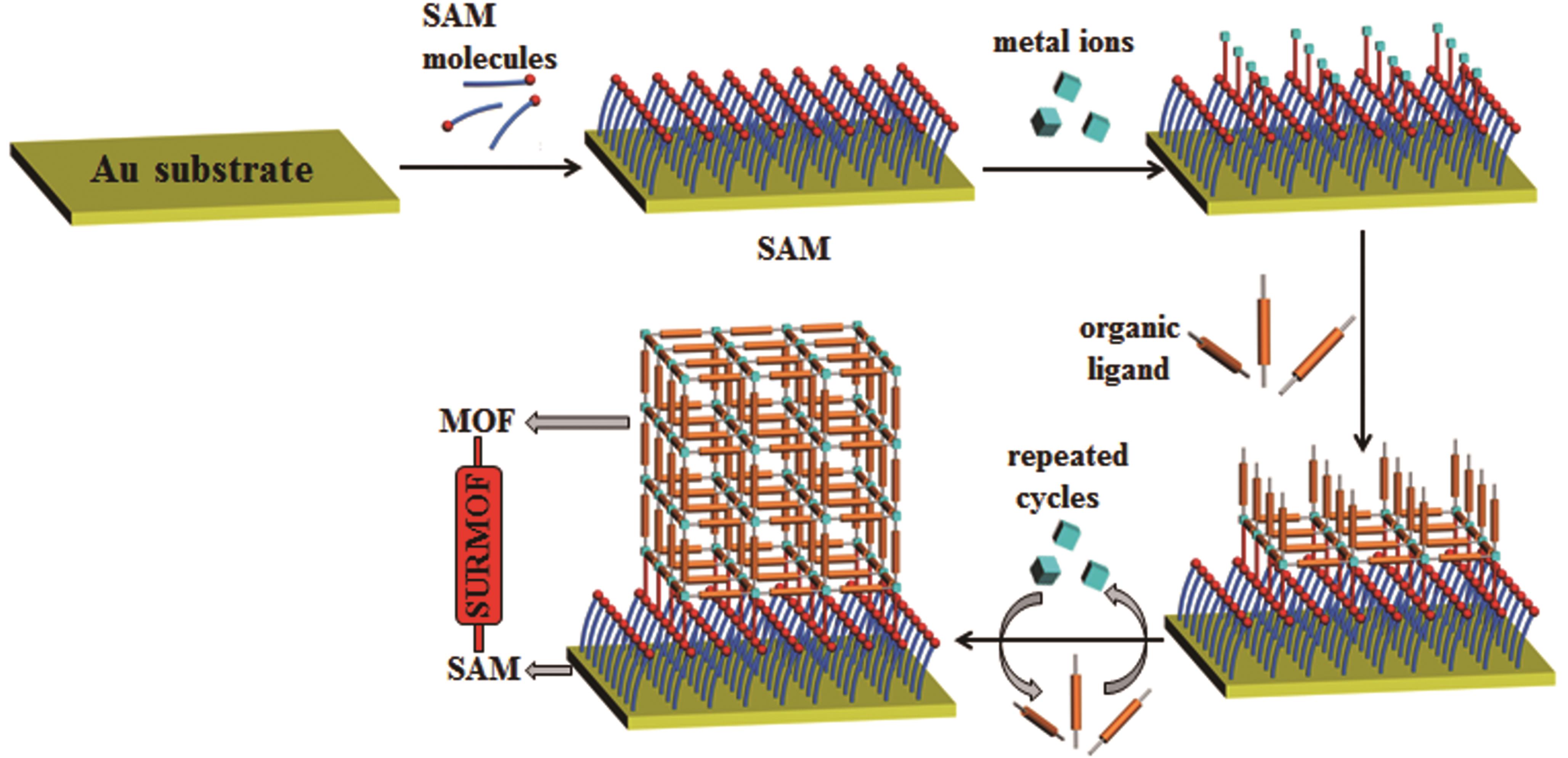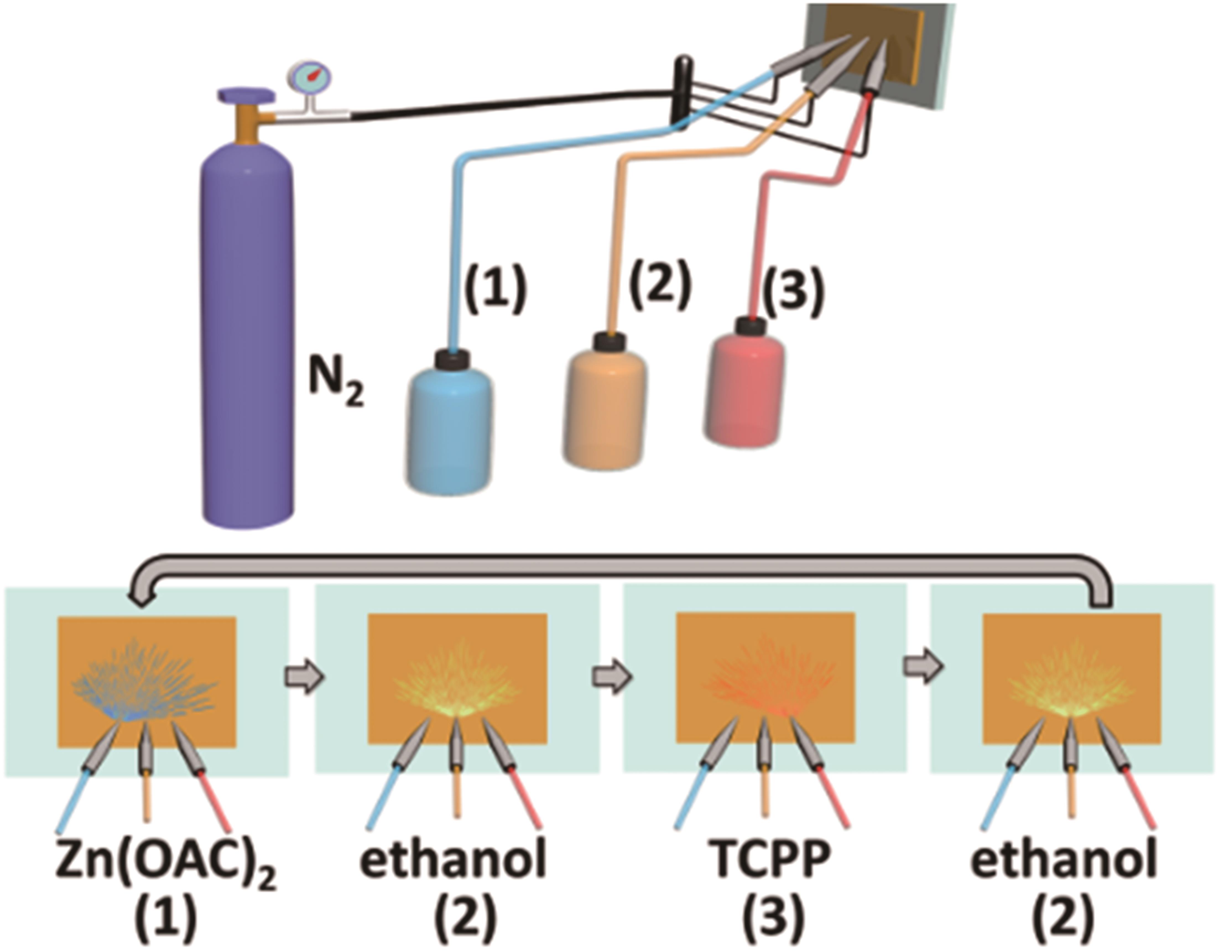
应用化学 ›› 2022, Vol. 39 ›› Issue (7): 1013-1025.DOI: 10.19894/j.issn.1000-0518.210310
• 综合评述 • 下一篇
表面配位金属-有机框架薄膜HKUST-1在光电应用中的研究进展
- 1.(中国福建光电信息科学与技术创新实验室(闽都创新实验室),福州 350108 )
2.中国科学院福建物质结构研究所结构化学国家化学重点实验室,福州 350002
-
收稿日期:2021-06-23接受日期:2021-10-25出版日期:2022-07-01发布日期:2022-07-11 -
通讯作者:谷志刚 -
基金资助:国家自然科学基金(21872148);中国科学院青年创新促进会(2018339);福建光电信息科学与技术创新实验室主任基金(2021ZR131)
Surface‑Coordinated Metal‑Organic Framework Thin Film HKUST‑1 for Optoelectronic Applications
Xue-Xian YANG1,2, Jian ZHANG1,2, Zhi-Gang GU1,2( )
)
- 1.Fujian Science & Technology Innovation Laboratory for Optoelectronic Information of China,Fuzhou 350108,China
2.State Key Laboratory of Chemistry for Structural Chemistry,Fujian Institute of Physical Structure,Chinese Academy of Sciences,Fuzhou 350002,China
-
Received:2021-06-23Accepted:2021-10-25Published:2022-07-01Online:2022-07-11 -
Contact:Zhi-Gang GU -
About author:zzgu@fjirsm.ac.cn
-
Supported by:the National Natural Science Foundation of China(21872148);the Youth Innovation Promotion Association of the Chinese Academy of Sciences(2018339);the Director's Foundation of Fujian Optoelectronic Information Science and Technology Innovation Laboratory(2021ZR131)
摘要:
金属-有机框架(MOFs)作为一种无机-有机杂化材料,由于其结构的多样性和独特的功能而在众多领域有着潜在的应用价值。尤其是液相外延层层组装的MOFs薄膜(称为表面配位MOFs薄膜,SURMOFs)因其具有可控的厚度、优选的生长取向以及均匀的表面等优点备受关注。本文总结了液相外延(LPE)层层组装MOFs薄膜的技术方法,如层层浸渍法、层层泵式法、层层喷雾法、层层旋涂法等组装方法,并介绍了经典的SURMOF HKUST-1的层层组装策略以及其在光致发光、光致变色、光催化以及电催化方面的相关应用。HKUST-1是经典的SURMOF材料之一,在光电领域具有广泛的应用,SURMOF HKUST-1具有以下独特的性能:可以作为发光载体实现良好的光学性能;具有独特的Cu催化活性位点的优势,有效地降解水中的污染物;因其具有介电特性而在电子器件方面有着潜在的应用。虽然HKUST-1在许多方面均具有独特的性能,但也面临着一些挑战:需要将薄膜的合成步骤简单化;薄膜结构和电催化行为间的机理也需要进一步的研究;降低HKUST-1的内阻的方法也需要进行改进。SURMOFs在大规模工业应用和扩展到其它未探索的领域还任重道远。
中图分类号:
引用本文
杨雪贤, 张健, 谷志刚. 表面配位金属-有机框架薄膜HKUST-1在光电应用中的研究进展[J]. 应用化学, 2022, 39(7): 1013-1025.
Xue-Xian YANG, Jian ZHANG, Zhi-Gang GU. Surface‑Coordinated Metal‑Organic Framework Thin Film HKUST‑1 for Optoelectronic Applications[J]. Chinese Journal of Applied Chemistry, 2022, 39(7): 1013-1025.

图3 自动层层浸渍法制备SURMOFs装置示意图[17]P0:样品夹的初始和最终位置; P1-P7:浸泡溶液容器; 1.聚四氟乙烯工作台; 2.容器的盖子; 3.夹子; 4.样品架; 5.样品; 6.位置控制器; 7.超声波清洗器; 8.淋浴; 9.容器盖的停放位置; 10.冲洗用泵和溶液瓶; 11.电脑
Fig.3 Setup illustration for the automatic layer-by-layer dipping growth of SURMOFs[17]P0: Initial and final position of the sample holder; P1-P7: Containers of immersion solutions; 1.Teflon working table; 2. Container lid; 3. Gripper; 4. Sample holder; 5. Sample; 6. Position controller; 7. Ultrasonic bath; 8. Shower; 9. Parking position of container lid; 10. Pump and solution bottle for showering; 11. Computer
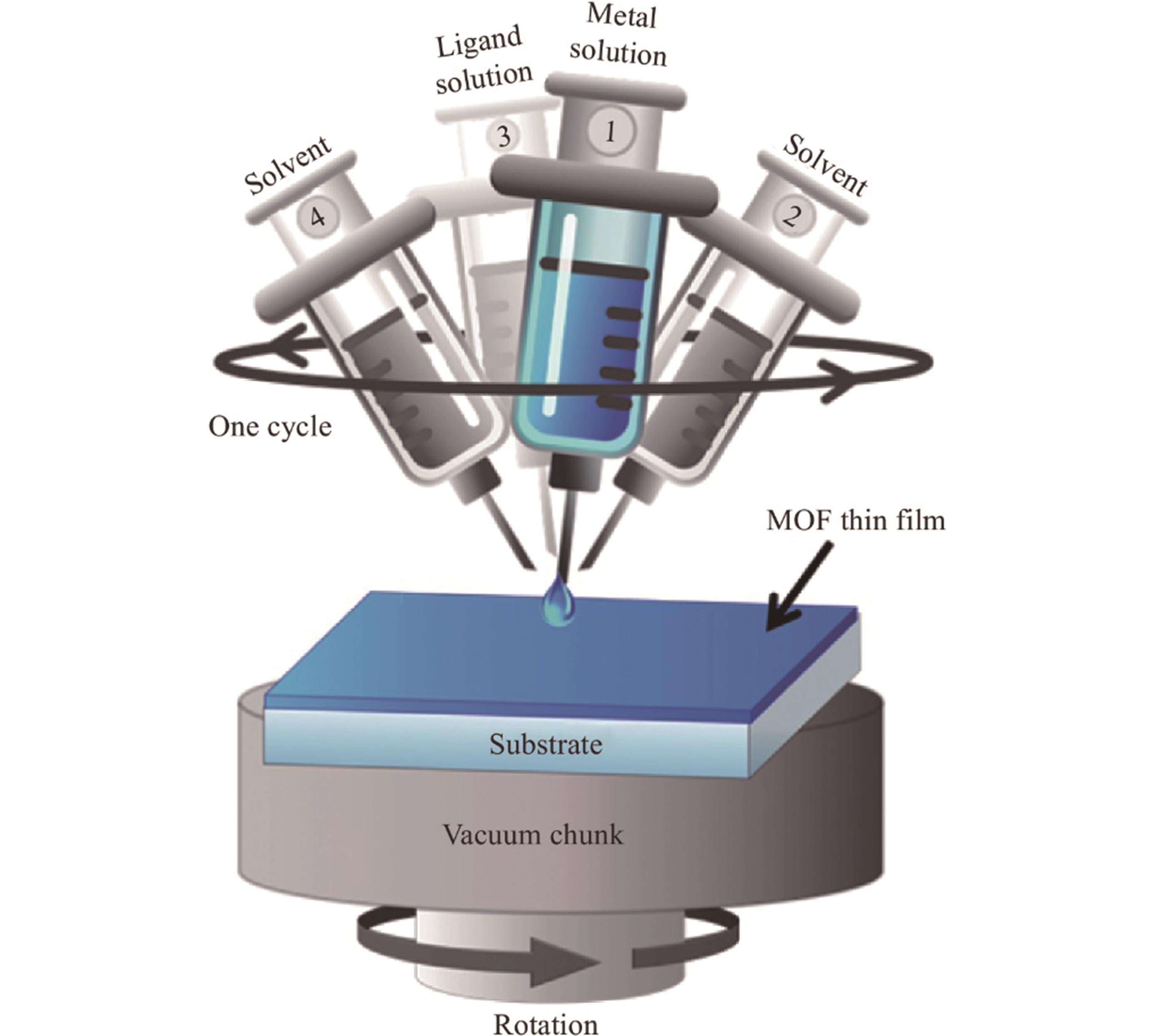
图6 使用适用于旋涂法的LPE方法制造多孔膜薄膜的装置示意图[20]
Fig.6 Schematic representation of the setup employed for the fabrication of MOF thin films using the LPE approach adapted to the spin-coating method[20]

图7 (A)采用液相外延法将Ln(pdc)3逐层负载到SURMOF孔道的示意图; (B)Ln(pdc)3结构示意图; (C)紫外光(365 nm)照射石英玻璃生长的Ln(pdc)3@HKUST-1薄膜和混合型Ln(pdc)3@HKUST-1薄膜的照片; (D)Eu(pdc)3@HKUST-1,Tb(pdc)3@HKUST-1和Gd(pdc)3@HKUST-1薄膜的发射光谱; (E)红色、绿色、蓝色发光的Ln(pdc)3@HKUST-1薄膜以及混合白光发射薄膜的CIE色度坐标图[27]
Fig.7 (A) Schematic diagram of Ln(pdc)3 encapsulated into SURMOF and grown insitu layer by layer using the liquid phase epitaxy method; (B) Schematic diagram of Ln(pdc)3 structure; (C) Photographs of Ln(pdc)3@HKUST-1 film on quartz glass under ultraviolet (365 nm) irradiation; (D) Solid-phase photoluminescence emission spectra of Eu(pdc)3@HKUST-1, Tb(pdc)3@HKUST-1,Gd(pdc)3@HKUST-1 films; (E) CIE chromaticity coordinate chart of red, green, blue and white emitting Ln(pdc)3@HKUST-1 film[27]
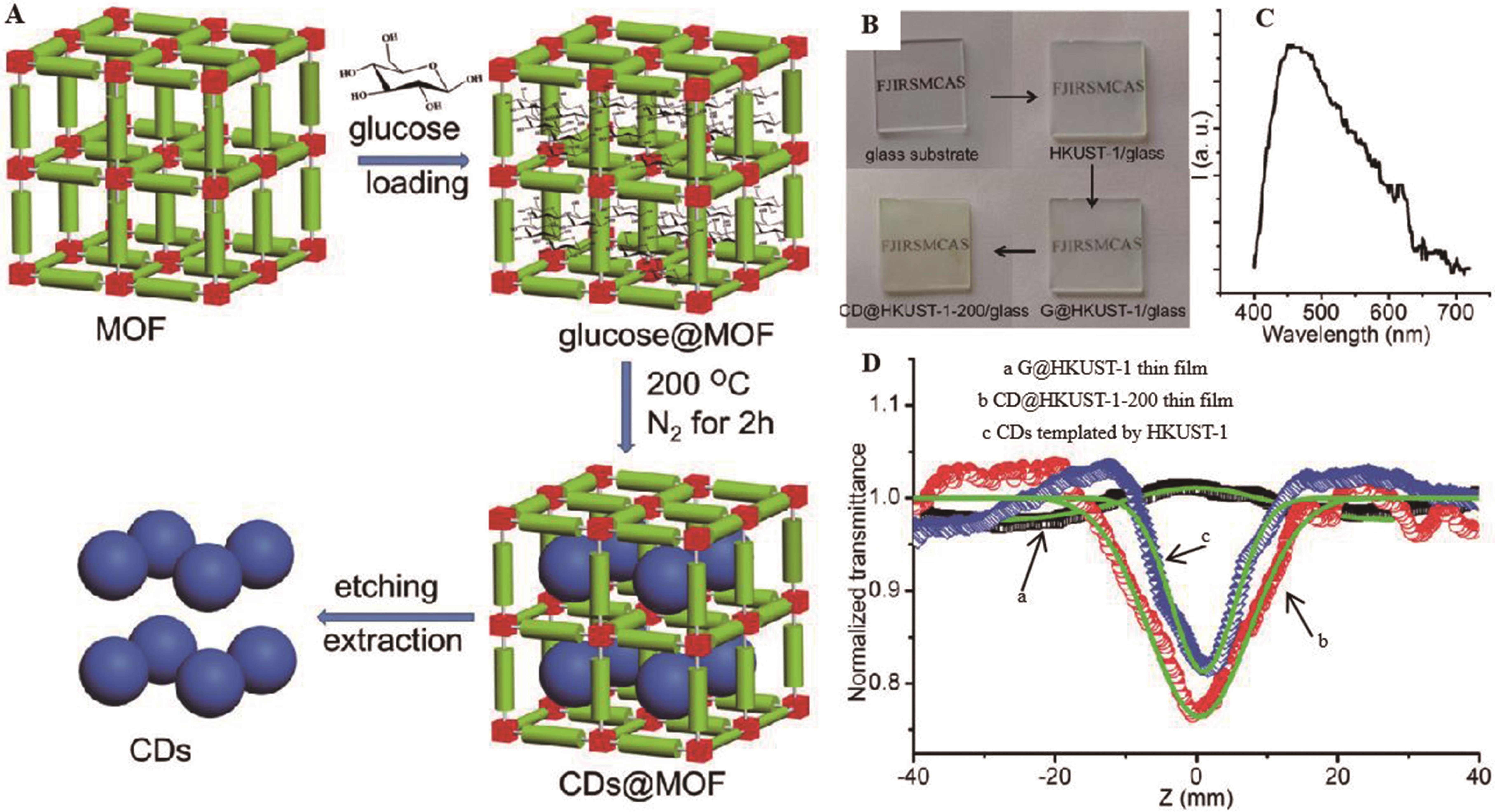
图8 (A) MOF模板法制备CDs示意图; (B) 石英玻璃、G@HKUST-1-200薄膜以及合成过程中的中间体材料照片; (C) CD@HKUST-1-200薄膜在350nm激发波长的荧光发射谱图; (D) G@HKUST-1薄膜、CD@HKUST-1-200薄膜和HKUST-1模板制备的CDs水溶液的开孔Z-扫描数据(点)以及532 nm激发波长下的理论拟合数据(实线)[28]
Fig.8 (A) Schematic diagram of CDs prepared by the MOF template method; (B) photos of the sample in the synthesis process; (C) photoluminescence of CD@HKUSTI-1-200 film; (D) open hole Z-sean data of CD@HKUST-1-200 film and HKUST-1 grown on quartz glass (point) and CDs aqueous solution made from G@HKUSTI-1 film with theoretical fitting data at 532 nm excitation wavelength[28]
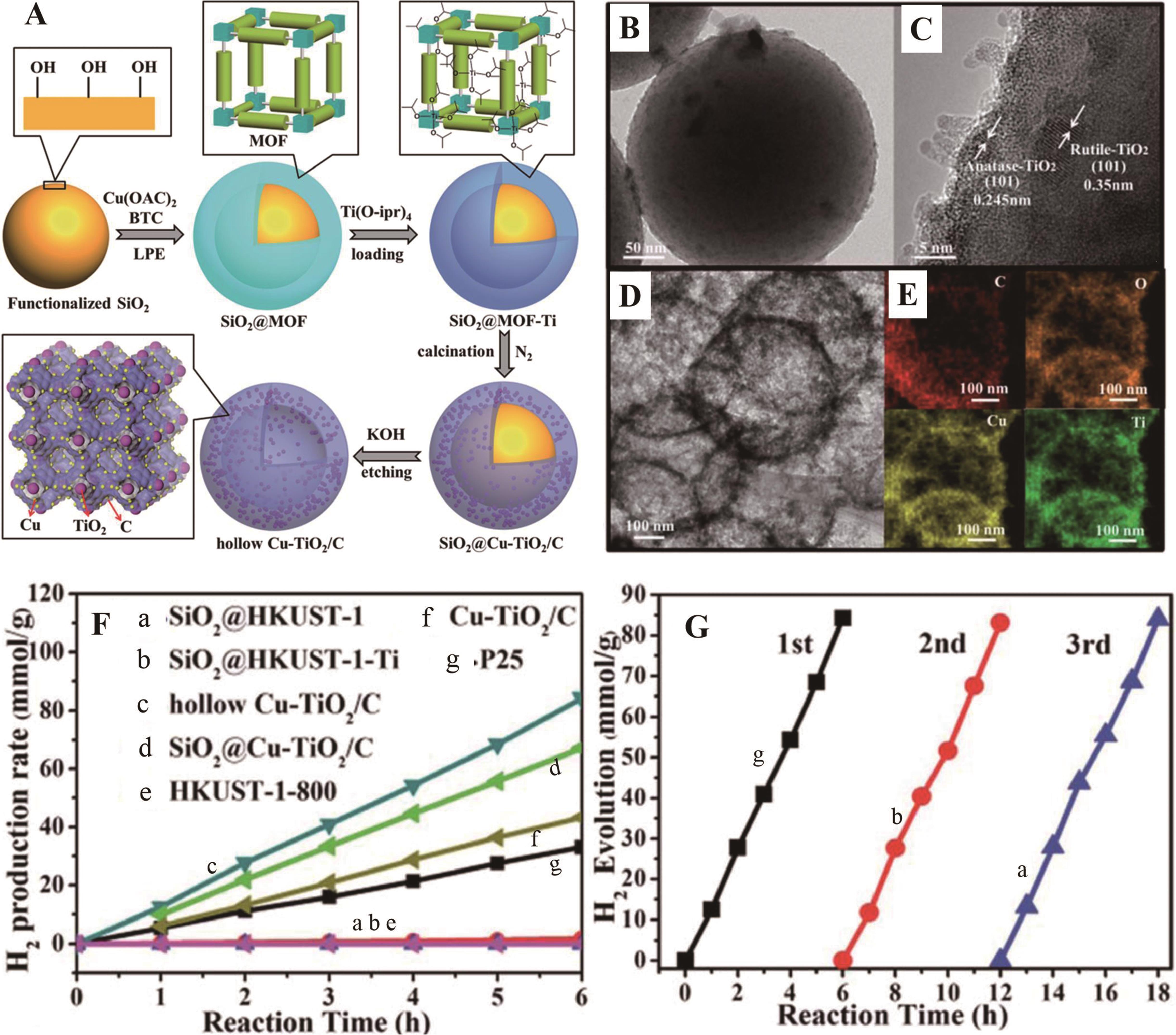
图9 (A)核壳结构SiO2@SURMOF纳米球制备Cu-TiO2中空碳纳米球示意图; (B)SiO2@Cu-TiO2/C的透射电镜图像; (C)样品中存在二氧化钛纳米颗粒晶格条纹的HRTEM图像; (D)Cu-TiO2/C纳米球的透射电镜图像; (E)Cu-TiO2/C纳米球中C、O、Cu和Ti的元素分布图; (F)HKUST-1-800、P25、SiO2@HKUST-1、SiO2@ HKUST-1-Ti、SiO2@Cu-TiO2/C、Cu-TiO2/C和中空Cu-TiO2/C纳米球的光催化制氢反应速率图; (G) 模拟太阳光照射下中空Cu-TiO2/C纳米球光催化制氢的可回收性[33]
Fig.9 (A) Schematic illustration of the preparation of hollow carbon nanospheres with Cu-TiO2 (Cu-TiO2/C) from core-shell structured SiO2@SURMOF nanospheres; (B) TEM image of SiO2@Cu-TiO2/C; (C) HRTEM image with lattice fringes of TiO2 nanoparticles existing within the sample; (D) TEM image of Cu-TiO2/C nanospheres; (E) TEM elemental mapping of C, O, Cu and Ti in hollow Cu-TiO2/C nanospheres; (F) Photocatalytic H2 production of HKUST-1-800, P25, SiO2@HKUST-1, SiO2@HKUST-1-Ti, SiO2@Cu-TiO2/C, Cu-TiO2/C and hollow Cu-TiO2/C nanospheres; (G) The recyclability of hollow Cu-TiO2/C nanospheres as photocatalysts in H2 production under simulated sunlight irradiation[33]
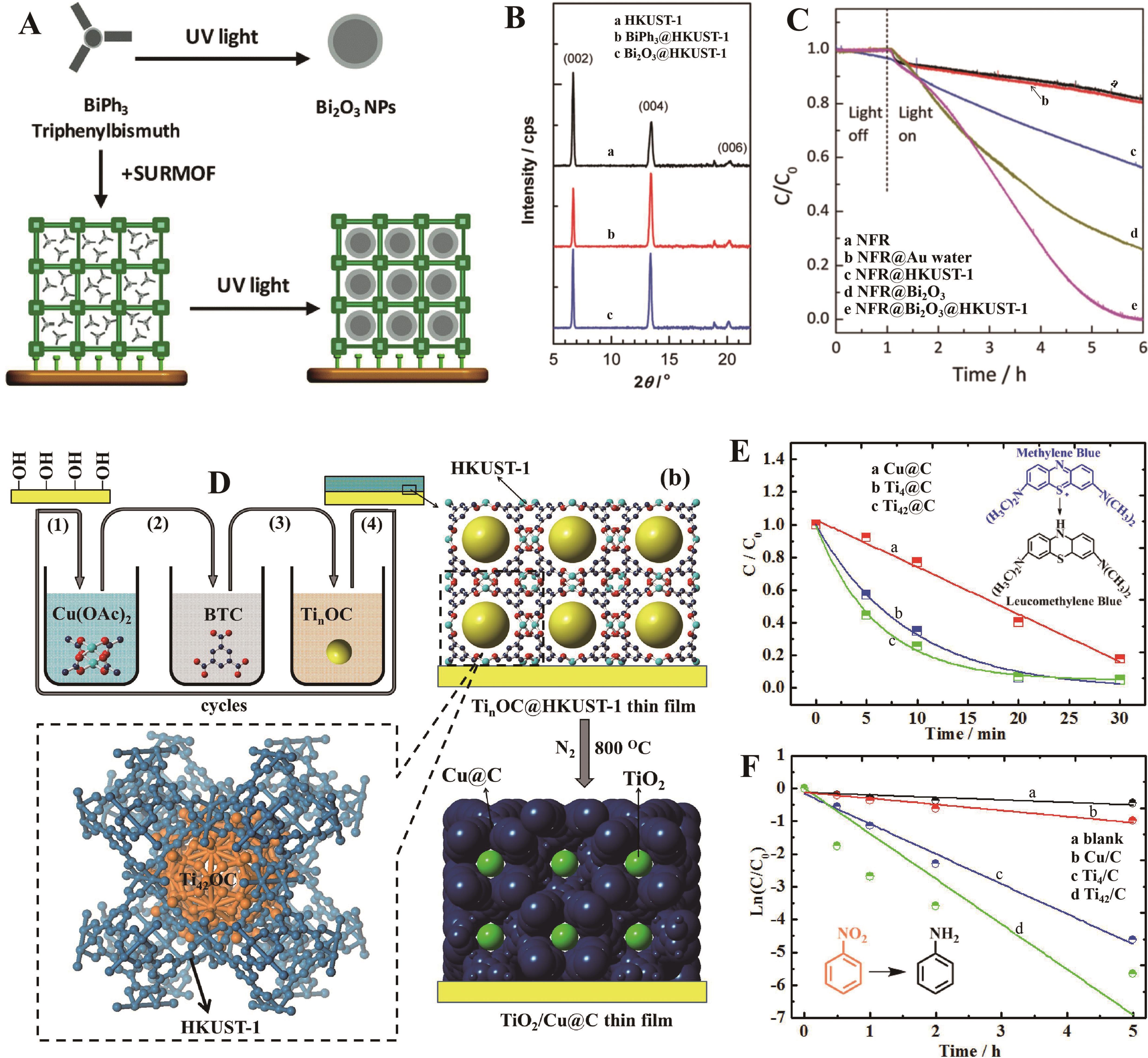
图10 (A)Bi2O3@HKUST-1超分子层; (B)Bi2O3@HKUST-1XRD图谱; (C)Bi2O3@HKUST-1光催化分解数据; (D)通过碳化负载金属氧簇的SURMOF来制备具有均匀尺寸分布的掺入金属纳米催化剂的碳薄膜; (E)煅烧后的薄膜具有较高的亚甲基蓝降解性能; (F)煅烧后的薄膜具有较高的硝基苯还原性能[34-35]
Fig.10 (A) Bi2O3@HKUST-1 SURMOF; (B) XRD patterns of Bi2O3@HKUST-1; (C) Photocatalytic decomposition data; (D) Carbon thin films with uniform size distribution were prepared by carbonizing SURMOF of supported metal oxygen clusters; (E) Calcinated thin films have high performance of methylene blue degradation; (F) Calcinated thin films have high performance of the reduction of nitrobenzene[34-35]
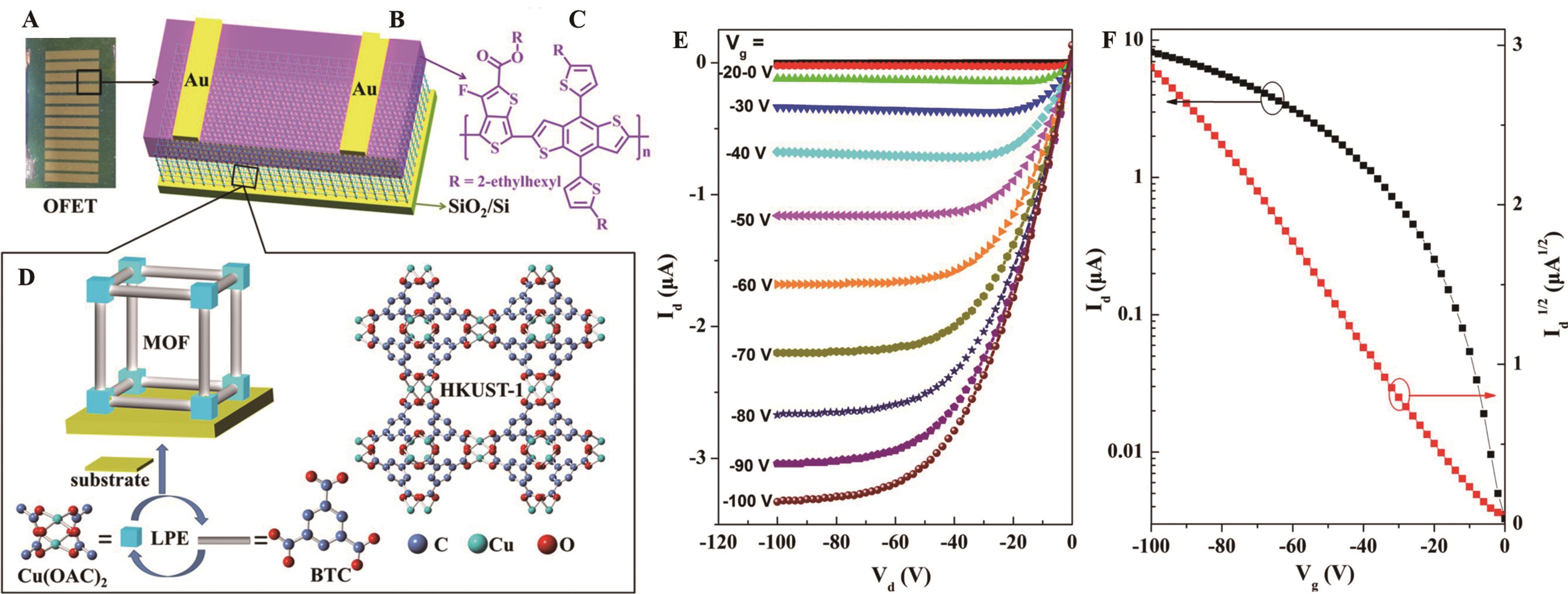
图11 (A)制备的OFET实物图; (B)HKUST-1薄膜修饰的SiO2介电层界面的OFET结构示意图; (C)半导体聚合物PTB7-Th的化学结构; (D)SURMOF HKUST-1的制备示意图及HKUST-1结构图; (E)HKUST-1/SiO2/Si结构OFET器件的输出特性; (F)HKUST-1/SiO2/Si结构OFET器件的传输特性[38]
Fig.11 (A) Sample diagram of field effect transistor (OFET); (B) Sketch diagram of HKUST-1 film modified SiO2 dielectric layer in the OFETs; (C) Structure of semiconductor polymer PTB7-Th; (D) Schematic diagram of liquid phase epitaxy layer by layer preparation of HKUST-1 and the structure; (E) The output characteristics of HKUST-1/SiO2/Si based OFETs; (F) The transmission characteristics of HKUST-1/SiO2/Si based OFETs[38]
| 1 | YAGHI O M, LI G M, GROY T L. Preparation of single crystals of coordination solids in silica gels: synthesis and structure of CuⅡ(1,4-C4H4N2)(C4O4)(OH2)4[J]. J Solid State Chem, 1995, 117(2): 256-260. |
| 2 | 刘康, 马鼎璇, 施展. 金属有机骨架材料在轻烃分离中的应用[J]. 应用化学, 2017, 34(9): 1006-1016. |
| LIU K, MA D X, SHI Z. Application of metal-organic framework materials in separation of light hydrocarbons[J]. Chinese J Appl Chem, 2017, 34(9): 1006-1016. | |
| 3 | STEPHEN S Y C, SAMUEL M F L, JONATHAN P H C, et al. A chemically functionalizable nanoporous material [Cu3(TMA)2(H2O)3]n[J]. Science, 1999, 283(5405): 1148-1150. |
| 4 | 贾静雯, 张梦凡, 张振民, 等. 过渡金属有机框架结构构件及电解水研究进展[J]. 有色金属科学与工程, 2021, 12(1): 49-66. |
| JIA J W, ZHANG M F, ZHANG Z M, et al. Research progress of transition metal organic frame structures and water electrolysis[J]. Nonferrous Met Sci Eng, 2021, 12(1): 49-66. | |
| 5 | 姚美任, 王康军, 张雅静, 等. 大位阻手性吡咯烷(salen)Mn(Ⅲ)配合物在烯烃不对称环氧化反应中的应用[J]. 应用化学, 2020, 37(8): 889-895. |
| YAO M R, WANG K J, ZHANG Y J, et al. Application of sterically hindered chiral (pyrrolidine salen) Mn(Ⅲ) complex in asymmetric epoxidation of alkenes[J]. Chinese J Appl Chem, 2020, 37(8): 889-895. | |
| 6 | 韩修, 康传清. (R)-α-硫辛酸合成方法的研究进展[J]. 应用化学, 2020, 37(11): 1236-1248. |
| HAN X, KANG C Q. Advances in synthetic methods of (R)-α-lipoic acid[J]. Chinese J Appl Chem, 2020, 37(11): 1236-1248. | |
| 7 | 史红玲, 王文杰, 李祥, 等. D-扁桃酸脱氢酶和L-亮氨酸脱氢酶级联催化的L-苯甘氨酸对映选择性生物合成[J]. 应用化学, 2020, 37(2): 168-174. |
| SHI H L, WANG W J, LI X, et al. Enantioselective biosynthesis of L-phenylglycine via cascade biocatalysis of D-mandelate dehydrogenase and L-leucine dehydrogenase[J]. Chinese J Appl Chem, 2020, 37(2): 168-174. | |
| 8 | 孙兰, 文玉华, 严家振, 等. 功能材料及应用[M]. 成都: 四川大学出版社, 2015: 148. |
| SUN L, WEN Y H, YAN J Z, et al. Functonal materials and applications[M]. Chengdu: Sichuan University Press, 2015: 148. | |
| 9 | 余佳芮, 陈帅, 辛星, 等. 二甲基亚砜改性聚(3,4-乙撑二氧噻吩):聚苯乙烯磺酸薄膜的研究及应用进展[J]. 应用化学, 2020, 37(12): 1343-1356. |
| YU J R, CHEN S, XIN X, et al. Research and application progress on dimethyl sulfoxide modified poly(3,4-ethylenedioxythiophene): poly(styrenesulfonic acid) films[J]. Chinese J Appl Chem, 2020, 37(12): 1343-1356. | |
| 10 | 衣彦林, 梁秋菊, 李令东, 等. 小分子优先结晶构筑聚合物/非富勒烯共混体系互穿网络结构[J]. 应用化学, 2019, 36(4): 423-430. |
| YI Y L, LIANG Q J, LI L D, et al. Constructing interpenetrating network of polymer/non-fullerene blend system by small molecule preferential crystallization[J]. Chinese J Appl Chem, 2019, 36(4): 423-430. | |
| 11 | 司浩楠, 张铮, 廖庆亮, 等. ZnO纳米结构及其在钙钛矿光伏电池中的应用[J]. 科学通报, 2020, 65(25): 2721-2739. |
| SI H N, ZHANG Z, LIAO Q L, et al. Nanostructures and their appilications in perovskite photovoltaic cells[J]. Chinese Sci Bull, 2020, 65(25): 2721-2739. | |
| 12 | TATSUHIKO N. GaP red light emitting diodes produced by a rotating boat system of liquid phase epitaxial growth[J]. J Electrochem Soc, 2019, 124(8): 1285-1289. |
| 13 | GU Z G, ZHANG J. Epitaxial growth and applications of oriented metal-organic framework thin films[J]. Coord Chem Rev, 2019, 378: 513-532 |
| 14 | 黄宇, 刘燕, 张静, 等. 光催化薄膜的亲水性及其应用[J]. 地球环境学报, 2018, 9(5): 415-433. |
| HUANG Y, LIU Y, ZHANG J, et al. Hydrophilicity of photocatalytic films and their applications[J]. Chinese J Earth Environ, 2018, 9(5): 415-433. | |
| 15 | 郭文明, 钟敏. 钙钛矿型太阳能电池制备工艺及稳定性研究进展[J]. 无机化学学报, 2017, 33(7): 1097-1118. |
| GUO W M, ZHONG M. Research progress on preparation technology and stability of perovskite solar cells[J]. Chinese J Inorg Chem, 2017, 33(7): 1097-1118. | |
| 16 | GU Z G, FU H, NEUMANN TOBIAS, et al. Chiral porous metacrystals: employing liquid-phase epitaxy to assemble enantiopure metal-organic nanoclusters into molecular framework pores[J]. ACS Nano, 2016, 10: 977-983. |
| 17 | GU Z G, PFRIEM A, HAMSCH S, et al. Transparent films of metal-organic frameworks for optical applications[J]. Micropor Mesopor Mater, 2015, 211: 82-87. |
| 18 | 石乃恩, 宋传远, 张俊, 等. 金属卟啉二维纳米晶的制备及其光电性能[J]. 物理化学学报, 2016, 32(10): 2447-2461. |
| SHI N E, SONG C Y, ZHANG J, et al. Preparation and photoelectric properties of metallic porphyrin 2D nanocrystals[J]. Chinese J Phys Chem, 2016, 32(10): 2447-2461. | |
| 19 | 谷志刚. 液相外延生长法层层组装金属-有机框架薄膜[J]. 功能高分子学报, 2019, 32(5): 533-540. |
| GU Z G. Layer assembly of metal-organic frame films by liquid phase epitaxial growth method[J]. Chinese J Funct Poly, 2019, 32(5): 533-540. | |
| 20 | VALERIYA C, OSAMA S, MOHAMED E. Advanced fabrication method for the preparation of MOF thin films: liquid-phase epitaxy approach meets spin coating method[J]. ACS Appl Mater Interfaces, 2016, 8(31): 20459-20464. |
| 21 | GONG X J, ZHANG D, DUAN L H, et al. Methane storage and synthesis of HKUST-1 prepared with different solvent[J]. China Pet Process Petrochem Technol, 2019, 21: 44-49. |
| 22 | 顾少轩, 雷丽文, 祝振奇, 等. 材料的化学合成、制备与表征[M]. 武汉理工大学出版社, 2016: 182. |
| GU S X, LEI L W, ZHU Z Q, et al. Chemical synthesis, preparation and characterization of materials[M]. Wuhan Technol University Press, 2016: 182. | |
| 23 | 周胜, 侯倩倩, 魏嫣莹, 等. 金属有机骨架膜的制备与应用进展[J]. 化工进展, 2019, 38(1): 467-484. |
| ZHOU S, HOU Q Q, WEI Y Y, et al. Progress in preparation and application of metal-organic skeleton membrane[J]. Chem Prog, 2019, 38(1): 467-484. | |
| 24 | 郭建维, 姜文钊, 傅淑琴, 等. 共价有机框架材料制备与应用的研究进展[J]. 广东工业大学学报, 2016, 33(1): 1-11. |
| GUO J W, JIANG W Z, FU S Q, et al. Research progress in preparation and application of covalent organic framework materials[J]. J Guangdong Univ Technol, 2016, 33(1): 1-11. | |
| 25 | GU Z K, HUANG Z D,HU X T, et al. In situ inkjet printing of the perovskite single-crystal array-embedded polydimethylsiloxane film for wearable light-emitting devices[J]. ACS Appl Mater Interfaces, 2020, 12(19): 22157-22162. |
| 26 | PRASAD G, MAHAJAN, DHANAJI P, et al. N-methyl isatin nanoparticles as a novel probe for selective detection of Cd2+ ion in aqueous medium based on chelation enhanced fluorescence and application to environmental sample[J]. Sens Actuators B: Chem, 2015, 220: 864-872. |
| 27 | GU Z G, CHEN Z, FU W Q, et al. Liquid‑phase epitaxy effective encapsulation of lanthanide coordination compounds into mof film with homogeneous and tunable white‑light emission[J]. ACS Appl Mater Interfaces, 2015, 7(51): 28585⁃28590. |
| 28 | GU Z G, LI D J, Z C, et al. MOF‑templated synthesis of ultrasmall photoluminescent carbon‑nanodot arrays for optical applications[J]. Angew Chem, 2017, 129(24): 6957-6962. |
| 29 | CHEN Z, GU Z G, FU W Q, et al. A confined fabrication of perovskite quantum dots in oriented MOF thin film[J]. ACS Appl Mater Interfaces, 2016, 8(42): 28737-28742. |
| 30 | GU Z G, FU W Q, LIU M, et al. Surface-mounted MOF templated fabrication of homochiral polymer thin film for enantioselective adsorption of drugs[J]. Chem Commun(Camb), 2017, 53(9): 1470-1473. |
| 31 | BARONI N, TURSHATOV A, WÖLL C, et al. Inkjet-printed photoluminescent patterns of aggregation-induced-emission chromophores on surface-anchored metal-organic frameworks[J]. ACS Appl Mater Interfaces, 2018, 10(30): 25754-25762. |
| 32 | STÖBER W, FINK A, BOHN E. Controlled growth of monodisperse silica spheres in the micron size range[J]. J Colloid Interface Sci, 1968, 26(1): 62-69. |
| 33 | CHEN H, GU Z G, ZHANG S H, et al. Hollow Cu-TiO2/C nanospheres derived from a Ti precursor encapsulated MOF coating for efficient photocatalytic hydrogen evolution[J]. J Mater Chem A, 2018, 6: 7175-7181. |
| 34 | GUO W, CHEN Z, YANG C W, et al. Bi2O3 nanoparticles encapsulated in surface mounted metal-organic framework thin films[J]. Nanoscale, 2016, 8(12): 6468-6472. |
| 35 | GU Z G,ZHANG D X,FU W Q,et al. Facile synthesis of metal‑loaded porous carbon thin films via carbonization of surface‑mounted metal‑organic frameworks[J]. Inorg Chem, 2017, 56(6): 3526⁃3531. |
| 36 | YU X J, GU Y, TERFORT A, et al. Concentration-dependent seeding as a strategy for fabrication of densely packed surface-mounted metal-organic frameworks (SURMOF) layers[J]. Chem Eur J, 2020, 26(23): 5185-5189. |
| 37 | WANG Z, NMINIBAPIEL D, SHRESTHA P, et al. Resistive switching nanodevices based on metal‑organic frameworks[J]. ChemNanoMat, 2016, 2(1): 67⁃73. |
| 38 | Gu Z G, CHEN S C, FU W Q, et al. Epitaxial growth of MOF thin film for modifying the dielectric layer in organic field‑effect transistors[J]. ACS Appl Mater Interfaces, 2017, 9(8): 7259⁃7264. |
| [1] | 尹爱萍, 孙金鱼, 石玉芳, 王迎进, 赵明根. 三联噻吩基查尔酮衍生物的线性光学性质和超快非线性光学响应[J]. 应用化学, 2022, 39(7): 1138-1146. |
| [2] | 郭晓峰, 李佳林, 王宇博, 金君素. 含硫高折射率光学树脂合成及性能研究进展[J]. 应用化学, 2022, 39(5): 723-735. |
| [3] | 孟丹, 郑开元, 陈珊珊, 卓钊龙, 王丽丽. 硅、氮共掺杂碳点荧光粉的制备及发光性能[J]. 应用化学, 2022, 39(11): 1766-1773. |
| [4] | 石玉芳, 白杨, 孙金鱼, 李军, 赵明根. 新型同分异构芘基查尔酮的理论研究和超快三阶非线性光学响应[J]. 应用化学, 2019, 36(9): 1035-1043. |
| [5] | 潘文慧,李文,屈璟涵,叶懿霈,屈军乐,杨志刚. 单分子定位超分辨显微成像有机荧光探针的研究进展[J]. 应用化学, 2019, 36(3): 269-281. |
| [6] | 孙金鱼, 王迎进, 石玉芳, 任光明, 赵明根. 基于二茂铁的两个查尔酮衍生物的合成及超快三阶非线性光学响应[J]. 应用化学, 2019, 36(3): 282-290. |
| [7] | 孙金鱼,王桂林,石玉芳,刘成琪,赵明根. 2-(芘-1-基)-1,8-萘啶的合成、理论计算及超快三阶非线性光学响应[J]. 应用化学, 2019, 36(10): 1172-1178. |
| [8] | 平林军, 刘秀, 尚树芳, 杨洲, 王冬, 曹晖, 何万里. 静电纺丝制备有机盐类非线性光学材料纳米纤维[J]. 应用化学, 2018, 35(8): 972-974. |
| [9] | 洪峰, 印月如, 田玉鹏, 吴杰颖. 具有近红外三阶非线性光学性质的咪唑邻菲罗啉钌配合物的合成及其与DNA作用特性[J]. 应用化学, 2018, 35(7): 818-824. |
| [10] | 李铸衡,张婳,刘殿骏,王振新. 三维光学断层技术在活体成像中的应用[J]. 应用化学, 2018, 35(12): 1411-1419. |
| [11] | 杜香莎, 李海洋, 刘恒, 李根恒, 李林科, 臧双全. 紫精修饰多功能Eu(Ⅲ)配合物的荧光开关、非线性光学和光电活性[J]. 应用化学, 2017, 34(9): 1024-1034. |
| [12] | 项盛, 邵俊, 冯立栋, 李杲, 陈学思, 边新超, 刘凤岐. 光学纯度对聚左旋乳酸结晶与熔融行为的影响[J]. 应用化学, 2016, 33(8): 887-893. |
| [13] | 石玉芳, 孙金鱼, 刘成琪, 赵明根. 1-(芘-1-基)-3-(4-甲氧基苯基)丙烯酮的合成及三阶非线性光学性质[J]. 应用化学, 2016, 33(2): 149-154. |
| [14] | 石玉芳, 孙金鱼, 王桂林, 刘成琪, 赵明根. 芳香查尔酮衍生物的合成、理论计算及三阶非线性光学性质[J]. 应用化学, 2016, 33(10): 1182-1188. |
| [15] | 石玉芳,孙金鱼,刘成琪,赵明根. 1-二茂铁基-3-[(9-乙基)咔唑-3-基]丙烯酮的合成及三阶非线性光学性质[J]. 应用化学, 2015, 32(9): 994-998. |
| 阅读次数 | ||||||
|
全文 |
|
|||||
|
摘要 |
|
|||||

